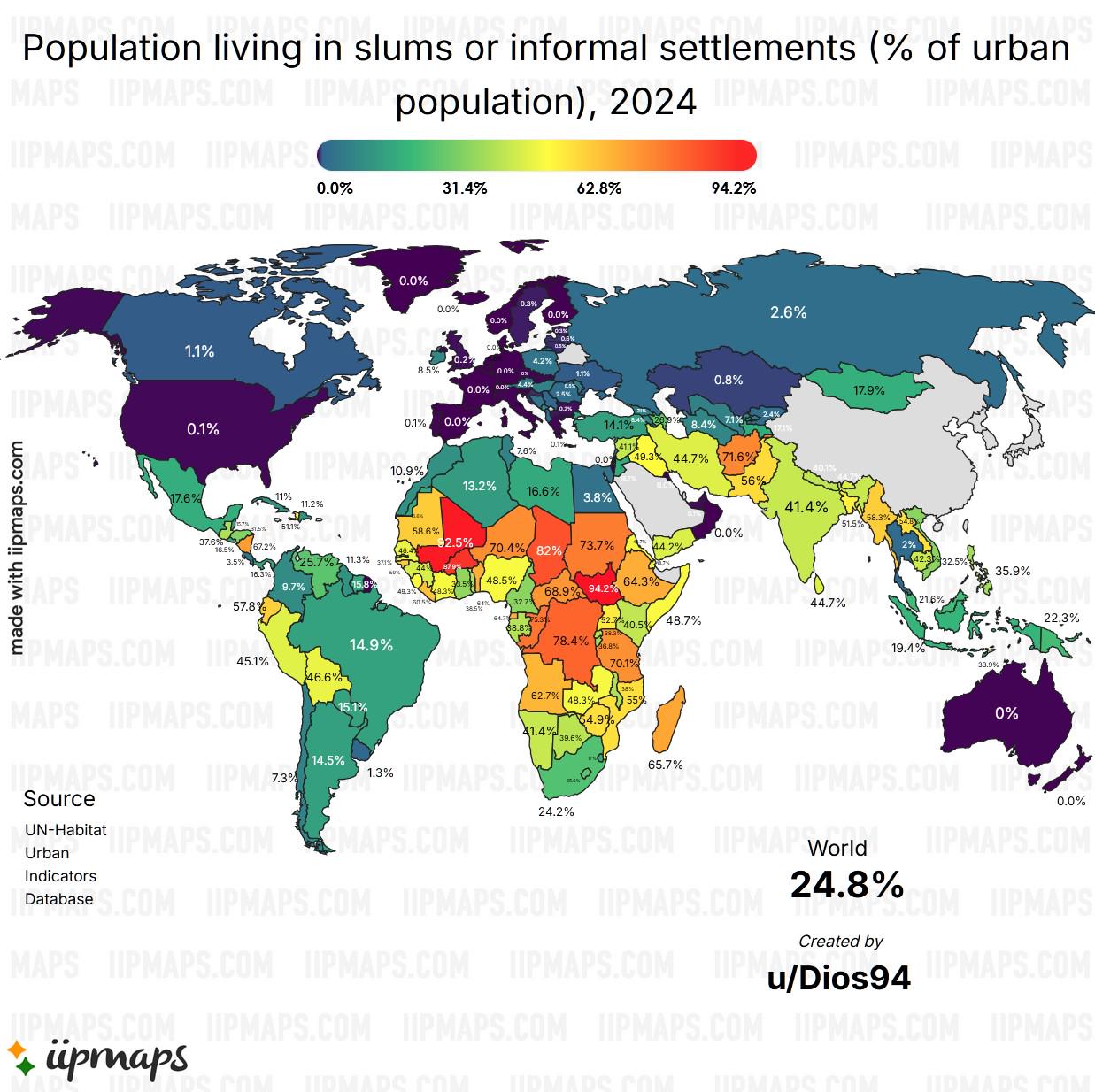Slum Population Percentage Map by Country


David Chen
Data Visualization Specialist
David Chen is an expert in transforming complex geographic datasets into compelling visual narratives. He combines his background in computer science ...
Geographic Analysis
What This Map Shows
The visualization titled "Population living in slums or informal settlements (% of urban population), 2024" provides a striking overview of the percentage of urban inhabitants residing in slums or informal settlements across various countries. This data, published by UN-Habitat and based on the latest comprehensive statistics from 2022, highlights the challenges faced by millions living in these precarious conditions. The map delineates the disparities in urban living standards, revealing how a significant portion of the urban population in some countries lacks access to basic infrastructure and services.
Deep Dive into Urban Slums and Informal Settlements
Urban slums and informal settlements are characterized by inadequate housing and insufficient access to essential services. According to UN-Habitat, several key indicators define these living conditions, including a lack of access to improved water, poor sanitation, overcrowded living areas, and the quality and durability of housing structures. Interestingly, informal settlements often emerge in response to rapid urbanization, where rural populations migrate to cities in search of better opportunities but are unable to secure formal housing.
Globally, it's estimated that one in every six urban residents lives in slums, a staggering figure that underscores the scale of this issue. Regions such as Sub-Saharan Africa and South Asia exhibit the highest percentages of slum populations, with cities like Dhaka, Mumbai, and Nairobi prominently featuring large informal settlements. For instance, in some areas of Dhaka, it's reported that up to 40% of the urban population resides in slums, highlighting severe socio-economic challenges.
The implications of living in slums extend beyond mere lack of shelter. Residents often face compounded vulnerabilities, including limited job opportunities, exposure to environmental hazards, and heightened risks during crises, such as pandemics or natural disasters. The COVID-19 pandemic starkly illustrated this, where many slum dwellers struggled to access healthcare services or maintain hygiene in overcrowded conditions. What's fascinating is that despite these challenges, many communities in slums show resilience and adaptability, often creating vibrant social networks and informal economies that sustain their livelihoods.
Regional Analysis
When analyzing the map by region, significant disparities emerge. In Sub-Saharan Africa, countries like Nigeria and Ethiopia have alarming percentages of urban populations living in slums. For instance, Nigeria's urban slum population approaches 70%, primarily driven by rapid urban migration and economic instability. Conversely, countries such as Senegal and Ghana, while still facing challenges, have made strides in reducing slum populations through targeted urban policies and improved housing initiatives.
In South Asia, India remains a focal point, with major cities like Mumbai and Kolkata grappling with expansive informal settlements. However, India has also seen innovative approaches, such as the Slum Rehabilitation Authority, which aims to provide better living conditions for slum dwellers. Meanwhile, in Latin America, countries like Brazil and Colombia have made significant progress in reducing slum populations through urban renewal projects and social housing initiatives, yet challenges persist in ensuring equitable access to resources for all urban citizens.
Significance and Impact
The significance of understanding slum populations goes beyond mere statistics; it connects deeply with issues of urban planning, public health, and social justice. As our world becomes increasingly urbanized, with more than half of the global population now residing in cities, addressing the needs of slum dwellers is crucial for sustainable urban development. The increasing frequency of extreme weather events and economic shocks further exacerbates the vulnerabilities faced by these populations, making it imperative for governments and organizations to implement effective policies.
Future projections indicate that without significant intervention, the number of people living in slums will continue to rise, especially in developing nations. Urban planners and policymakers must prioritize infrastructure development and inclusive growth strategies to combat this trend. As we move forward, it is vital to foster dialogue and collaboration among stakeholders to create resilient urban environments where everyone has access to safe and adequate housing.
In conclusion, the map serves as a powerful reminder of the critical need for informed policies and community engagement in tackling the challenges of urban slums. By focusing on this issue, we can work toward building a future where urban living is not synonymous with suffering and deprivation, but rather with opportunity and dignity for all.
Visualization Details
- Published
- October 23, 2025
- Views
- 8
Comments
Loading comments...